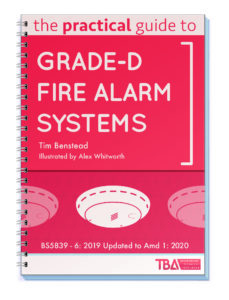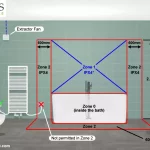

Grade D Fire Alarm Systems Guide
The Practical Guide to Grade D Fire Alarm Systems (updated to BS 5839-6 Amd 1 2020) was written to support the electrician or fire alarm engineer as they seek to understand their roles and responsibilities when designing, installing, commissioning, testing and maintaining Grade D fire alarm systems for domestic properties & dwellings.
Providing guidance for the working electrician on fire risk assessments, selecting appropriate grade / category of system, maintenance and servicing and situations requiring a logbook.
This guide to Grade D Fire Alarm Systems gives the electrician or fire alarm engineer a clear understanding of their roles and responsibilities, whether that be as a contractor, designer, landlord or housing manager, and provides a suitable context in which all such work should be carried out.
The book is written in a clear and concise style and covers all aspects relating to competence, fire risk assessment, design, installation, commissioning, and maintenance.
Fire Alarm Grades
- Grade A (highest)
- Grade C
- Grade D1
- Grade D2
- Grade F1
- Grade F2 (lowest)
Whilst many electricians will be familiar with the installation of smoke and heat alarms within a domestic premises, too many will be less familiar with the specific recommendations of BS 5839-6 for fire detection and fire alarms.
Too often the electrical contractor complies with the minimum recommendation detailed within local guidance, such as Approved Document B in England and Wales and the Technical Handbook in Scotland and fails to account for specific risks within a dwelling when deciding upon the Grade and Category of system.
For landlords and those having responsibility for fire detection and fire alarm systems, guidance is equally necessary as they need to satisfy themselves that they are in compliance with relevant standards and legislation.
See > Landlord’s and Rental Properties – New Electrical Safety Requirements
–
A sneak peek into Grade D fire alarms (sample pages only)
The Practical Guide to Grade D Fire Alarm Systems supports the electrical contractor and all those involved with fire safety in dwellings in understanding their roles and responsibilities which covers:
- The nature of fire and fire spread
- Fire risk assessment
- Competence
- Design
- Installation
- Commissioning and certification
- Maintenance
- Servicing procedures by competent persons
The Practical Guide to Grade-D Fire Alarm Systems was written by Tim Benstead MSc, MIET, MCIBSE, BEd(Hons), Tim is currently the Chair of JPEL64/B, a member of JPEL64, and has been a member of FSH12 and FSH12/1 (the BSI committee responsible for the standards BS 5839-1 and BS 5839-6) for more than fifteen years. He is also a member of FSH17, the committee responsible for the production of BS 8629 dealing with Emergency Evacuation Systems.
Associated Fire Detection BS Standards
Fire detection and fire alarm systems for buildings.
BS 5839-1 : Code of practice for design, installation, commissioning and maintenance of systems in non-domestic premises.
BS 5839-6 : Code of practice for the design, installation, commissioning and maintenance of fire detection and fire alarm systems in domestic premises. Part 6: Code of practice for the design, installation, commissioning and maintenance of fire detection and fire alarm systems in domestic buildings.
BS 5839-9 : Code of practice for the design, installation, commissioning and maintenance of emergency voice communication systems.








